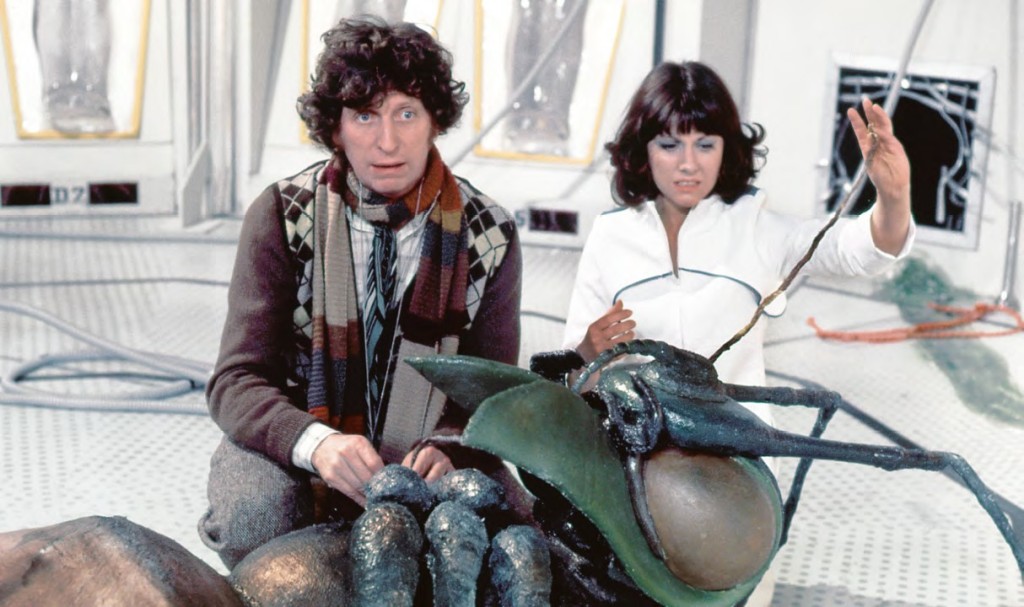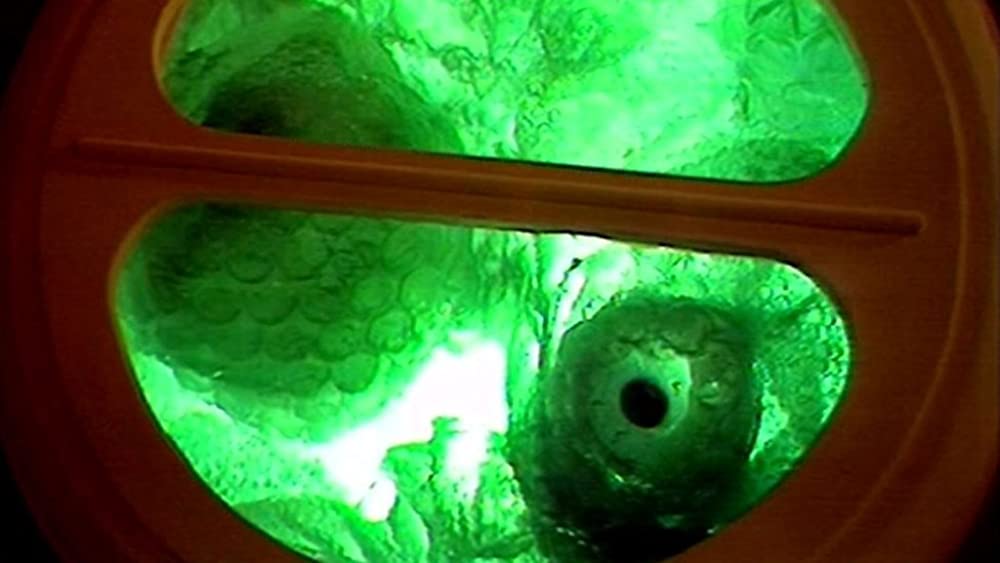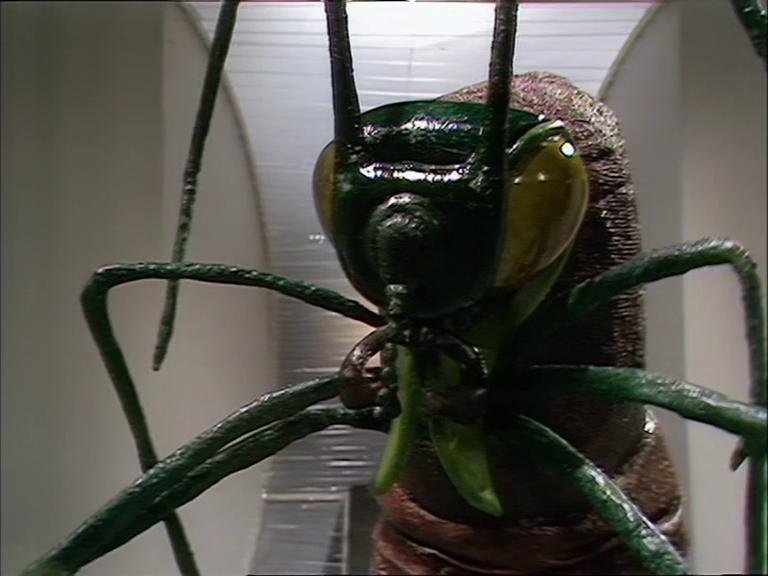
There are innumerable places out there recounting the long and complicated history of Doctor Who (which will be celebrating its sixtieth anniversary next year), its place within the history of Science Fiction television, its importance to the BBC and UK TV in general, and its dedicated fandom. All of that has already been thoroughly interrogated, and by people far more knowledgeable than me.
So, instead, let’s talk about monsters.
As the old story goes, when the series was being developed in the early sixties, the top brass at the BBC explicitly told the writers to avoid stories about “bug-eyed monsters.” However, the second serial ready to be produced completely ignored this edict, and due to a lack of other suitable scripts, it went ahead—and unfortunately for the anti-bug-eyed-monster producers, the monsters introduced in that second serial were the Daleks, who became immediate pop culture icons in the UK, complete with novelty Christmas records. The show’s time and space-traversing format allowed the stories to theoretically go anyway and do anything, but from that point forward that anywhere often involved some kind of alien monster.
Unlike the other influential creature TV series I’ve written about from around the same time period, like The Outer Limits and Ultraman, there was never a requirement for a Doctor Who story to include a monster, and there are many that don’t—but the monsters in that series have become such a tradition (almost certainly because of the popularity of the Daleks, due as much to the distinctive visuals invented by production designer David Cusick as it was to the scripts by Terry Nation, although it was the latter who got the copyright) that the series, from the original 1963-1989 run or the current one that began in 2005, has never veered away from them. With a basic concept that gives them a near endless choice of settings and storylines, the possibilities for just what kind of monsters can show up are equally as endless, which has led to a panoply of highly imaginative monsters, some of them becoming recurring presences on the show like the Daleks did, while others only appeared once, but may still have left an impression. As in many classic monster movies, the creativity on display in the stories and monsters is crucial because the limited budget of a BBC production means that the special effects, back then and today, are never going to be impressive or believable, so they have to find other ways to engage, or terrify, the audience.
The original series reached its peak popularity in the mid-seventies, after the starring role of the Doctor was given to Tom Baker (whose pre-Doctor career we briefly touched on in the post about The Mutations—although the performance that got him the job was his turn as the villain in the Ray Harryhausen effects vehicle The Golden Voyage of Sinbad, another monster connection), the fourth actor to take the part, who brought a particular laid-back quirkiness to a role that had been defined from the beginning by eccentricity. Due to the length of his tenure (seven years, the longest any actor has played the Doctor) and the fact that his were the first episodes to air on US TV, Baker ended up becoming the most well-known lead for many years (it sounds like he was aware of this at the time, too, leading to some notoriously diva-ish behaviour on set.) His second ever storyline, the four-episode “The Ark in Space”, aired from January to February 1975, and is a fan favourite—it’s also an important one for the history of the show and its approach to monsters, signalling a new direction that has cast a long shadow over the entire series.

This new direction was masterminded by producer Philip Hinchcliffe and writer Robert Holmes, the latter often considered the single best scripter of the original series: in order to bring in viewers older than their juvenile base audience, they leaned into the horror element, often blending the Science Fiction with a Gothic sensibility that included straight homages to monster movie classics like Dracula, Frankenstein, and The Mummy. There was a precedent for this for this shifting tone: the series had always had a reputation for scaring younger viewers, and it reached even greater heights of terror when the series went full colour in 1970 and introduced such distinctively creepy adversaries as the living plastic mannequins in the serials “Spearhead From Space” and “Terror of the Autons”; as well, there are comparisons to be made between Doctor Who‘s approach and the Sci-Fi/horror serials of Nigel Kneale, especially the Quatermass trilogy (and also previous subject The Abominable Snowman), which aired on the BBC in the fifties. Hinchcliffe and Holmes pushed the straight terror and the more subtle atmosphere of dread in these stories to their limits, to the point where the series became the target of British moral crusaders and the BBC was intimidated into canning Hinchliffe and taking the show in a lighter direction (among the people who took over in the latter half of the seventies was Hitchhiker’s Guide to the Galaxy author Douglas Adams, but that’s a whole other story.) Although technically short-lived, the “Gothic Horror” years of the series still yielded some of the franchise’s most beloved stories, such as “The Ark in Space.”

The time-and-space-jumping TARDIS brings the Doctor and his human companions Sarah Jane Smith (Elizabeth Sladen) and Harry Sullivan (Ian Marter, who would write novelizations of the series after departing it as an actor) to a seemingly empty space station, and is their usual wont, they wander around for a bit and deal with mysterious and dangerous technology such as automated weapons systems, teleportation devices, and cryogenics tubes. The Doctor deduces that the station is from the far future of Earth, and by the end of the first episode they discover that it contains records of all human knowledge and cryogenically frozen people and animals, all waiting out some unknown event. There are also signs of sabotage aboard, and slime trails created by some unknown extraterrestrial organism. Their activity ends up instigating the resuscitation of the leaders of the station, the project originator nicknamed Noah and his second-in-command Vira, who see the damage and crew members missing from their cryo chambers and accuse our heroes of being behind it. The actual culprit is a green slug that Harry spotted early, which turns out to be the larval stage of the insectoid parasite Wirrn, who have infested the station and are using the frozen humans as a food supply.

This could be all be played highly cliche, but Robert Holmes’ scripts (although this one is a complete rewrite of a story by another longtime Who writer, John Lucarotti) are often chockablock with distressing detail and deadpan humour that arises from a mixture of the mundane and ridiculous with the horror—for example, we first see a Wirrn when a dead one falls out of a closet, acting as an admirably deflated cliffhanger. At a basic level, the story is about one of the greatest achievements of human civilization—a vast ark that has preserved life for millennia in a bid to rebuild the planet after it is ravaged by solar flares—that is undermined by space pests. Not just any space pests, either, but ones that reproduce by taking over host bodies and absorbing the knowledge of their hosts into their hive mind, using that to further aid their infestation. There have been many comparisons between this story and the similar body horror of Alien, which this predates, and both are similarly inspired by the real world biology of parasitic wasps, which the Doctor actually talks about in the story itself.
A particularly striking theme across many of Doctor Who‘s monster stories is a contrast between the monster and the setting. In this case, the setting is more pure Sci-Fi, but the gleaming white technology and optimistic futurism of the ark being invaded by the putrid green Wirrn is still a notable example of how the show features the monsters “invading” a narrative where they don’t belong (which is also what our protagonists are doing…it’s kinda the central gimmick of the series.) Other stories would use similar contrasts in historical settings, but they’re probably at their most effective when the monsters are in more mundane contemporary places, taking the horror to the audience’s backyard—the newer series in particular has utilized that frequently.

From the second episode onward, much of the horror comes from Noah, who is infected by the Wirrn and is slowly transforming into one of their kind. As a example of Doctor Who‘s level of effects, this is represented by parts of his body being covered with bubble wrap spray painted green, but as the infection spreads it becomes a more effectively gruesome effect, and actor Kenton Moore puts in the properly melodramatic effort of portraying someone slowly losing control of their own body (not dissimilar to Kneale’s The Quatermass Experiment.) The Wirrn themselves, and their slimy larvae especially, are portrayed with puppets that are sometimes effective for the time and budget, even if the full-grown insects have fairly limited movement. They are carried along by the rather nauseating menace they represent, a spreading parasite plague taking advantage of people at their most vulnerable—much like Kneale’s stories, the horror is based mostly in visceral and disturbing implications. Despite Tom Baker’s oftentimes flippant manner, his ability to sell the seriousness of a story like this also really contributes to their effectiveness, regardless of the believability of the special effects.
Another highly fascinating touch Holmes brings to the story is in the initial characterization of Noah, who is regarded with a level of awe by the other revived crew members, but is also shown to be immediately angered by the presence of “regressives” on the ship potentially poisoning his carefully-selected gene pool. Yes, for all the Doctor’s praise about human ingenuity in building the ark, there is an undercurrent of eugenics to it that makes it far more unsavoury—it seems appropriate that the guy most obsessed with genetic purity is the one who ends up being morphed into a giant alien insect (even if he does redeem himself in the end by asserting his humanity.) That uncomfortable atmosphere is only reinforced when you notice that all the crew members we meet are Caucasian Brits—this was something that was apparently not intended in the script, where Holmes indicated that Vira was black, which better fits the Doctor saying that “all races and creeds” were represented on the ark. Regardless, the cynicism inherent in this portrayal of humankind is a consistent theme in Holmes’ Doctor Who stories.

There are several avenues for that cynicism elsewhere, too. The other revived members of the crew gripe about the situation like blue collar workers, saying that they would have preferred to have dealt with the solar flares (they seem a bit more down-to-Earth than Vira, who is constantly put-off by Harry’s use of contemporary slang.) When the Wirrn explain their motivations, they tell us that they were pushed off their homeworld by human colonists, losing access to their original host species and floating aimlessly in space until they came upon the ark—this would give them a more understandable revenge drive (and Doctor Who has done intergalactic colonialist subtext elsewhere, siding with the weird aliens just as often as not), except that they then say that they want to take the knowledge of humanity to become a technological civilization, galaxy-conquering ambitions that may mar any potential sympathy we might have for these gross green bugs. This could just be a way to justify the inevitable exploding of the Wirrn at the end of the final episode, but given how many of the humans in the story are portrayed, it feels like a more broadly askew view of the universe.

That view of the universe, a place of infinite wonder but also infinite strangeness and terror, has been the main driver of the series for all its sixty years, and it often demonstrates that with its use of monsters. Later stories would take the baseline set by “The Ark in Space”’s crafty sci-fi horror and go even wittier, often aiming for genre-fluid experimentation that more than made up for low budget effects—but the effective simplicity of this story is why it works as a baseline. A plot about alien bugs sounds like quotidian genre fare, but a combination of clever writing, capable actors, and a willingness to unsettle the audience gives Doctor Who‘s take on the subject that clearly stayed with people for years. The series excels at being a monster vehicle because, when it was at the top of its game (as it was during this part of the seventies), it always adds an intelligent, nightmarish layer to them.
